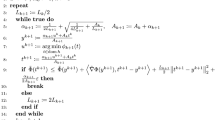Abstract
Algorithms are presented that are specifically designed for solving general nonlinear multicommodity spatial price equilibrium problems, i.e., problems with nonlinear transportation cost functions, nonlinear supply and demand functions, inter-commodity congestion effects, intercommodity substitution and complementarity effects and interactions among transportation links and among spatially separated markets. The algorithms are specializations of an iterative method for solving nonlinear complementarity problems that requires solving a system of nonlinear equations at each iteration. The algorithms exploit the network structure of the problems to reduce the size of the system of equations to be solved at each iteration. The decision rules for determining which equations are to be included in the system at each iteration are extremely simple, and the remainder of the computational work is carried out by the nonlinear equation solver. Because of this, the algorithms are very easy to implement with readily available software. In addition, since the decision rules only require sign information, only the final system needs to be solved with precision.
Similar content being viewed by others
References
H.Z. Aashtiani, “The multimodal traffic assignment problem,” Ph.D. Dissertation, Alfred P. Sloan School of Management, MIT (Cambridge, MA, 1979).
B.H. Ahn and B.S. Seong, “A parametric network method for computing nonlinear spatial equilibria,” Department of Management Science, Korea Advanced Institute of Science and Technology (Seoul, Korea, 1984).
R. Asmuth, B.C. Eaves and E.L. Peterson, “Computing economic equilibria on affine networks with Lemke's algorithm,”Mathematics of Operations Research 4 (1979) 209–214.
S. Dafermos “An iterative scheme for variational inequalities,”Mathematical Programming 26 (1983) 40–47.
M. Florian and M. Los, “A new look at static spatial price equilibrium models,”Regional Science and Urban Economics 12 (1982) 579–597.
T.L. Friesz, P.T. Harker and R.L. Tobin, “Alternative algorithms for the general network spatial price equilibrium problem,”Journal of Regional Science 24 (1984) 475–507.
T.L. Friesz, R.L. Tobin and P.T. Harker, “Variational inequalities and convergence of diagonalization methods for derived demand network equilibrium problems,” CUE-FNEM-1981-10-1, Department of Civil and Urban Engineering, University of Pennsylvania (Philadelphia, PA, 1981).
T.L. Friesz, R.L. Tobin, T.E. Smith and P.T. Harker, “A nonlinear complementarity formulation and solution procedure for the general derived demand network equilibrium problem,”Journal of Regional Science 23 (1983) 337–359.
C.R. Glassey, “A quadratic network optimization model for equilibrium single commodity flows,”Mathematical Programming 14 (1978) 98–107.
G.J. Habetler and M.M. Kostreva, “On a direct algorithm for nonlinear complementarity problems,”SIAM Journal of Control and Optimization 16 (1978) 504–511.
P.C. Jones, R. Saigal and M. Schneider, “A variable dimension homotopy for computing spatial equilibria,”Operations Research Letters 3 (1984) 19–24.
P.C. Jones, R. Saigal and M. Schneider, “Computing nonlinear network equilibria,”Mathematical Programming 31 (1985) 57–66.
P.C. Jones, R. Saigal and M. Schneider, “Demand homotopies for computing nonlinear and multi-commodity spatial equilibria,”Lecture Notes in Economics and Mathematical Systems 249 (Springer-Verlag, Berlin Heidelberg, 1985) 118-135.
P.C. Jones, R. Saigal and M. Schneider, “A variable dimension homotopy on networks for computing linear spatial equilibria,”Discrete Applied Mathematics 13 (1986) 131–156.
M.M. Kostreva, “Elasto-hydrodynamic lubrication: a non-linear complementarity problem,”International Journal for Numerical Methods in Fluids 4 (1984) 377–397.
O.L. Mangasarian, “Equivalence of the complementarity problem to a system of nonlinear equations,”SIAM Journal on Applied Mathematics 31 (1976) 89–92.
L. Mathiesen, “Computational experience in solving equilibrium models by a sequence of linear complementarity problems,”Operations Research 33 (1985) 1225–1250.
J. More' and W. Rheinboldt, “OnP- andS-functions and related classes ofn-dimensional nonlinear mappings,”Linear Algebra and its Applications 6 (1973) 45–68.
K.G. Murty, “Note on a Bard-type scheme for solving the complementarity problem,”Opsearch 11 (1974) 123–130.
J.M. Ortega and W.C. Rheinboldt,Iterative solution of nonlinear equations in several variables (Academic Press, New York, 1970).
J.S. Pang, “A hybrid method for the solution of some multi-commodity spatial equilibrium problems,”Management Science 27 (1981) 1142–1157.
J.S. Pang, “Solution of the general multi-commodity spatial equilibrium problem by variational and complementarity methods,”Journal of Regional Science 24 (1984) 403–414.
J.S. Pang and D. Chan, “Iterative methods for variational and complementarity problems,”Mathematical Programming 24 (1982) 284–313.
J.S. Pang and P.S.C. Lee, “A parametric linear complementarity technique for the computation of equilibrium prices in a single commodity spatial model,”Mathematical Programming 20 (1981) 81–102.
P.A. Samuelson, “Spatial price equilibrium and linear programming,”American Economic Review 42 (1952) 283–304.
M.H. Schneider, “The expanding equilibrium algorithm,” submitted toACM Transactions on Mathematical Software (1986).
T. Takayama and G.G. Judge, “Equilibrium among spatially separated markets: a reformulation,”Econometrica 32 (1964) 510–524.
T. Takayama and G.G. Judge,Spatial and Temporal Price and Allocation Models (North-Holland, Amsterdam, 1971).
M. Udomkesmalee, “Models and algorithms for spatial price equilibria with congestion,” Ph.D. Dissertation, Department of Industrial Engineering, Northwestern University (June 1985).
Author information
Authors and Affiliations
Rights and permissions
About this article
Cite this article
Tobin, R.L. A variable dimension solution approach for the general spatial price equilibrium problem. Mathematical Programming 40, 33–51 (1988). https://doi.org/10.1007/BF01580722
Received:
Revised:
Issue Date:
DOI: https://doi.org/10.1007/BF01580722




